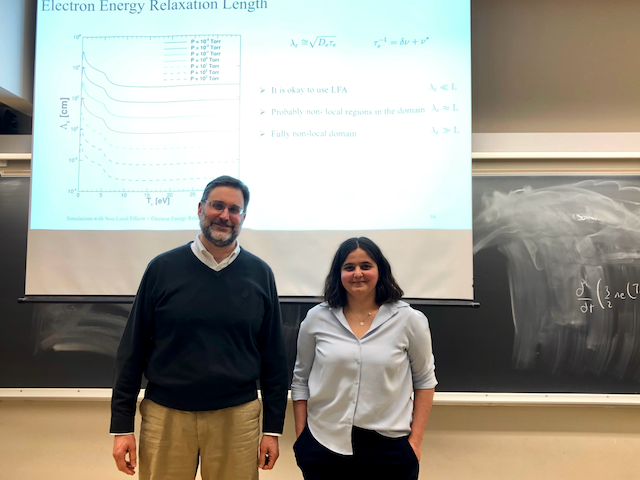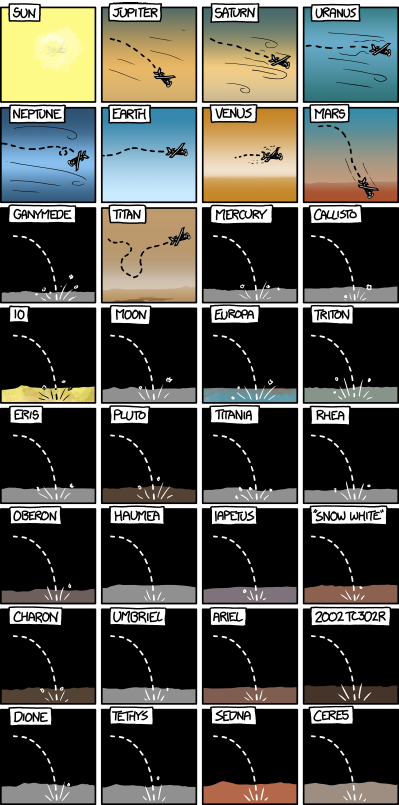Flow Resolution
News in 2018-2019 from Prof. Poggie's research group.
Upstream Influence on Reattachment Unsteadiness
The video below shows schlieren imaging of a Mach 2.9 reattaching shear layer flow, with and without air injection near the backward facing step. The experiments were carried out by Poggie and Smits in 1991-1992 in the Princeton University 8 in by 8 in Mach 3 wind tunnel, and were described in AIAA Paper 1992-0178 (DOI 10.2514/6.1992-178.)
If you look closely near the backward-facing step, you can see the vertical jet of air and the corresponding shock when the blowing is turned on. The separated shear layer also shifts down, and the the shear layer growth rate increases on the low-speed (lower) side. There is a corresponding increase in the size of the large-scale turbulence structures. Later in the video, the camera pans to the reattachment region, where the unsteady reattachment shock system is apparent. When blowing is turned on, there is a very obvious increase in the intensity of the reattachment shock unsteadiness.
In the early 1990s, computer simulation of such unsteadiness was not feasible. With current computational resources and modern algorithms, this is now possible, and our research group is studying the unsteadiness of the reattaching shear layer flow computationally (Deshpande and Poggie, AIAA 2019-3439).
Summer Reading
Back in May, Purdue hosted the Purdue Symposium on Ethics, Technology, and the Future of War and Security. Among the list of distinguished speakers were Paul Scharre and Peter W. Singer, and I've had a chance this summer to read their recent books.
Autonomous weapons are not science fiction; they are already here and operate under varying degrees of human supervision. In Army of None, Scharre considers the many dangers, and some potential good, that could come from introducing more autonomy in weapons systems. He covers some of the history of the subject, from World War II era noise-seeking torpedoes to the recent Aegis Combat System, and discusses calls for a ban on fully autonomous weapons systems.
Another book addressing the dangers of future conflict, Like War by Singer and Brooking, is about the new venue for national conflict provided by social media. In the past, propaganda was one-way, from a national-level source to the public. The two-way interaction of social media allows extremely targeted and adaptive disinformation, and marketing techniques from the commercial world are being adapted for political manipulation.
The Elmer F. Bruhn Award
Many thanks to our undergraduates for the honor of the 2019 Elmer F. Bruhn Award!
The undergraduate course that I teach is AAE 334, Aerodynamics. AAE 334 is a like an engineering boot-camp, where we cover almost all of an 1100-page Aerodynamics textbook in one semester. I am very pleased that our students have come out of such a tough class with a favorable impression. That work can pay off: several students have told me that taking the class helped them get through a tough job interview.
Undergraduate Scholarships
The Purdue School of AAE has several undergraduate scholarships. Apply here by May 1.
Sidewall Effects in a Supersonic, Turbulent Compression Ramp Flow
Our research group has recently published a study of large-scale unsteadiness in a Mach 2.25 compression ramp flow (Physics of Fluids, 2019) and a follow-on study on the effect of confining sidewalls under the same conditions (Physical Review Fluids, 2019).
The presence of strong confinement by sidewalls reduced the streamwise extent of separation and had a profound influence on the nature of the large-scale separation unsteadiness. The movies below show the instantaneous skin friction on the bottom wall (orange contours) and the density field in the center plane (grayscale) for the two flows. The first is an open case with periodic sidewall boundary conditions and the second is a closed duct flow with confining sidewalls.
More movies of the periodic boundary conditions case are here and the movies for the sidewalls case are here. This work was supported by a grant from the Air Force Office of Scientific Research and by supercomputer hours supplied under a DoE INCITE Award.
Aircraft in Other Atmospheres
Back in the Spring 2017 Semester, I challenged AAE 334 Aerodynamics students with an extra credit project to design autonomous air vehicles to fly on other large bodies in the solar system and collect scientific data. There was no one right answer for this project, and students came through with some very creative designs, including "air"-planes, helicopters, and lighter-than-"air" vehicles.
Real missions are being developed around this sort of idea, but there many design challenges. Randall Monroe captured the essence of the problem:
Hypersonic Boundary Layer Instability
Laminar-turbulent transition of hypersonic boundary layers is a crucial physical process for aerospace vehicle design because of its strong influence on heating rates. Doctoral student Geoffrey Andrews has been carrying out simulations of this phenomenon for conditions corresponding to the experiments of Stetson et al. (1991).
The movie below shows some of his results. The configuration is a cylinder flow at Mach 8 with forcing (blowing/suction) at the wall. Full results will be reported in AIAA 2019-0581
Shear Layer Flapping
In subsonic flow, low-energy shear layer flapping is mostly inconsequential. At supersonic speeds, however, the flapping carries the reattachment shock back and forth, acting like a hammer on an aircraft surface. Doctoral student Akshay Deshpande has been studying this phenomenon, data mining the long-duration, Mach 2.9 reattaching shear layer computation of Leger, Bisek, and Poggie (2017). This DDES computation was run for 2 million iterations, capturing 0.5 s of simulated physical time.
Movies of the center-plane of the computation are shown below. On the left are the raw data, and on the right are data processed by a low-pass temporal filter to highlight the large-scale flapping. The movie frame rate is slowed by a factor of 200 relative to the simulated physical time (0.05 s/frame vs. 0.25 ms/frame).
Full results will be reported in AIAA 2019-1874.
Opportunities in Fluids and Plasmas at LLNL
At a recent DoE workshop on exascale computing, I learned that Lawrence Livermore National Laboratory has a graduate student summer program that offers some interesting opportunities for students specializing in fluid dynamics and plasma physics. On the same page there is also information on post-doc opportunities.
Opportunities in Hypersonics Research
Our research group may have an opening starting in the Spring 2019 semester for 1-2 graduate students or a post-doc. The proposed work is in the area of hypersonic flow simulation. Because of US government restrictions, candidates for these positions must be US citizens. While funding is not certain yet, interested candidates should contact Prof. Poggie (jpoggie@purdue.edu).






